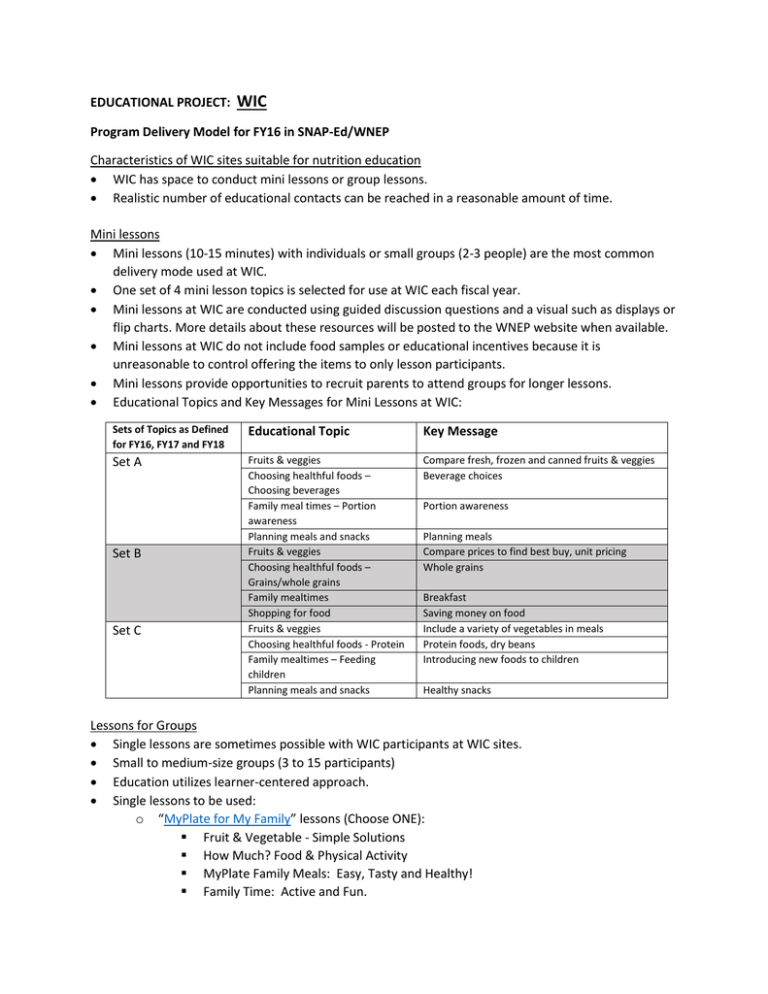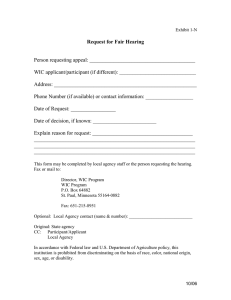WIC
advertisement

EDUCATIONAL PROJECT: WIC Program Delivery Model for FY16 in SNAP-Ed/WNEP Characteristics of WIC sites suitable for nutrition education WIC has space to conduct mini lessons or group lessons. Realistic number of educational contacts can be reached in a reasonable amount of time. Mini lessons Mini lessons (10-15 minutes) with individuals or small groups (2-3 people) are the most common delivery mode used at WIC. One set of 4 mini lesson topics is selected for use at WIC each fiscal year. Mini lessons at WIC are conducted using guided discussion questions and a visual such as displays or flip charts. More details about these resources will be posted to the WNEP website when available. Mini lessons at WIC do not include food samples or educational incentives because it is unreasonable to control offering the items to only lesson participants. Mini lessons provide opportunities to recruit parents to attend groups for longer lessons. Educational Topics and Key Messages for Mini Lessons at WIC: Sets of Topics as Defined for FY16, FY17 and FY18 Educational Topic Key Message Set A Fruits & veggies Choosing healthful foods – Choosing beverages Family meal times – Portion awareness Planning meals and snacks Fruits & veggies Choosing healthful foods – Grains/whole grains Family mealtimes Shopping for food Fruits & veggies Choosing healthful foods - Protein Family mealtimes – Feeding children Planning meals and snacks Compare fresh, frozen and canned fruits & veggies Beverage choices Set B Set C Portion awareness Planning meals Compare prices to find best buy, unit pricing Whole grains Breakfast Saving money on food Include a variety of vegetables in meals Protein foods, dry beans Introducing new foods to children Healthy snacks Lessons for Groups Single lessons are sometimes possible with WIC participants at WIC sites. Small to medium-size groups (3 to 15 participants) Education utilizes learner-centered approach. Single lessons to be used: o “MyPlate for My Family” lessons (Choose ONE): Fruit & Vegetable - Simple Solutions How Much? Food & Physical Activity MyPlate Family Meals: Easy, Tasty and Healthy! Family Time: Active and Fun. o “Feeding for Healthy Eating” (single lessons are still being pilot tested but may be included in FY16 plans) o Selected “Eating Smart, Being Active” lessons (Choose ONE): Feeding infants Feeding toddlers Eating during pregnancy o Selected revised Money for Food lessons on planning meals and shopping for food, 2 lessons to be developed spring of 2015 (Choose ONE) o “Cooking Matters at the Store” planned in collaboration with WIC or Head Start as referral source. (Teach as single lesson) o Work with your local WIC director to see how you could assist them with implementing the “BePC WIC Group Education Toolkit” lessons. Each lesson planned for at least 30 minutes of teaching time; 45 to 60 minutes of teaching time per lesson is ideal. Indirect Education Walk-bys: When it is not possible to offer Mini lessons, occasional Walk-by educational events can be offered. Topics taught at WIC Walk-bys should be consistent with topics selected for the fiscal year. Multi-level & Collaborative Activities Work with WIC staff and community partners to reduce barriers to WIC participants utilizing their fruit and vegetable benefits, i.e, from WIC food package and/or Farmers’ Market Nutrition Program. (Increased use of fruit & vegetable benefits) Work with community partners and organizations to organize efforts, integrate services and create awareness around: Introduction and promotion of EBT at farmers’ markets Community gardens available to WIC families Fruit and vegetable prescription/incentive programs Retail settings that highlight healthy food options , e.g. shelf tags, other signage, point of purchase/selection prompts Opportunities to be physically active Refer to WI DHS Nutrition, Physical Activity, and Obesity Program for more information: https://www.dhs.wisconsin.gov/physical-activity/index.htm Evaluation There are some state evaluation tools for this educational project. Additional and revised tools are in development. March 2015


